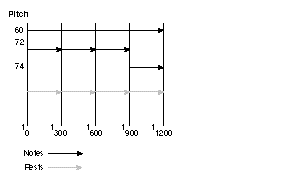
QuickTime 3 Reference
Music events specify the instruments and notes of a musical composition. A group of music events is called a sequence. A sequence of events may define a range of instruments and their characteristics and the notes and rests that, when interpreted, produce the musical composition.
The event sequence required to produce music is usually contained in a QuickTime movie track, which uses a media handler to provide access to the tune player, or an application, which passes them directly to the tune player. QuickTime interprets and plays the music from the sequence data.
The events described in this section initialize and modify sound-producing music devices and define the notes and rests to be played.
Events are constructed as a group of long words. The uppermost four bits (nibble) of an event's long word defines its type.
Durations of notes and rests are specified in units of the tune player's time scale (default 1/600 second). For example, consider the musical fragment shown in Figure 3 .

Assuming 120 beats-per-minute, and a tune player's scale of 600, each quarter note's duration is 300. Figure 4 shows a graphical representation of note and rest data.
Figure 4 Duration of notes and rests

The General event specifies the types of instruments or sounds used for the subsequent Note events. The Note event causes a specific instrument, previously defined by a General event, to play a note at a particular pitch and velocity for a specified duration of time.
Additional event types allow sequences to apply controller effects to instruments, define rests, and modify instrument knob values. The entire sequence is closed with a Marker event.
In most cases, the standard Note and Controller events (two long words) are sufficient for an application's requirements. The Extended Note event provides wider pitch range and fractional pitch values. The Extended Controller event expands the number of instruments and controller values over that allowed by a Controller event.
The following sections describe the event types in detail.